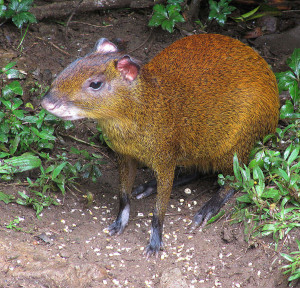Contribution from our friend Randy of RandysPlanet.com
Susan glances sidelong at me. “Randy…you’re not going to…”

But I’m not flinching. I’m locked in a predatory stare-down. This is high drama—I stare at the agouti and he stares at me. He is frozen in the road in front of us, in a pose very characteristic of the agouti: nothing moving but the whiskers, and one foreleg raised. You can tell this guy is at the bottom of the food chain. He’s locked and loaded.
“Randy, really…the poor thing…” Susan says—but she’s starting to laugh.
Simultaneously I jump, yell and flap my arms.
What happens next is remarkable, though you have to be quick to catch it. Every tiny arrector pili muscle attached to every hair follicle on the rear third of his body contracted at once by sympathetic nervous response, so that all the hairs on the rump of the creature, which are several times longer than the rest and are banded in light and dark shades, explode outward in a great circular fan, briefly making his rump twice the diameter it was, which wasn’t small, and in a blink he has vanished from the frame like a cartoon animal, leaving nothing behind but a little puff of dust.
I don’t shoot animals or cage them, but I get to have some fun.
* * * *
If you walk the roads of Akumal, you have seen agoutis (Dasyprocta punctate). They look sort of like guinea pigs (and they’re related), but they’re twice as long and five times heavier. Your first impression when you see one is of a fairly rotund, dumpy little animal, but look closer. You’ll notice that they’re actually pretty long-legged. And if you simultaneously jump, yell and flap your arms, they will put their athleticism on full display. They’re on the menu of every predator from medium-sized on up, which means: eagles, coatis, feral dogs, the larger snakes, and all but one of our line-up of jungle cats, which total five species culminating in the jaguar. These animals live a tough life, and they’re more capable than they look. They’re fleet-footed, they can jump six feet straight up from a standstill, they can climb, and they can swim.
And there’s one other predator—they are heavily hunted by humans, and that’s starting to affect their numbers in places. In Trinidad they even hunt them with dogs. The agoutis, even when they are fleeing for their lives, are simply not programmed to leave their relatively small territories, so the outcome is never in much question, but even so, an agouti can keep a hunting dog occupied for a couple of hours.
They eat mostly fruit and seeds, although, like most successful animals, they have more than one trick, and they will eat eggs if they find them, and even
forage on the beach for things like crabs and shellfish. But fruit is what they’re really into, and they often find it by sound. They love the thump of a piece of fruit hitting the ground, and they have discriminating ears—they really love it if it sounds ripe.
They can live up to twenty years in captivity (less in the wild), which is pretty good for a rodent. They mate for life, which is also unusual. Actually, it’s very unusual. Though ninety percent of birds are monogamous, only three percent of mammals are—and by the way, we’re not technically among them. Humans are called socially monogamous, meaning that we stay paired and raise young together, but we have a tendency to, well, increase our genetic odds on the side. We humans have our failings, but the fidelity of the agouti is beyond reproach. Only bereavement will cause an agouti’s eye to wander.
That said, the male is not allowed anywhere near the young. He defends the territory, which will be up to four acres, and will always include both fruit trees and a water source, but he leaves the mother and her young alone. The female gives birth to a couple of pretty capable babies who will be moving and eating on their own within an hour (this is also unusual for rodents). She stashes them in their own burrow, into which she cannot even fit—and neither can a lot of their predators, which is the whole point. She calls them out now and then and nurses them at the entrance. As they grow, they will have to enlarge the “kids’ room,” or find a new one.
Agoutis are tremendously important seed distributors. When food is plentiful, they will bury seeds to eat later (it’s called scatter-hoarding), and inevitably they don’t get back to all of them, so they sort of end up farming their own favorite fruit trees. They are one of only two animals who can crack open a Brazil nut (the other is the macaw), so you’re well advised to treat their jaws with respect.
You probably see more of them than Susan and I do because we don’t live in Akumal anymore. We bought some acreage and became what all our old Akumal chums call “jungle people,” and unlike Susan and I, agoutis prefer life in town. Along with coatis and iguanas, they have figured out that where there are people, there are fewer predators, and maybe some easy food. Out here in the jungle, on the other hand, where they have to make an honest living, all three of those animals are a lot more scarce.
And you might not be aware that “agouti” is also a color. It is a word used to refer to the look of their beautiful, grizzled coat, which is created by alternating bands of light and dark on each hair shaft. It’s quite beautiful.
Now you know.
©Randy Fry 2016
RandysPlanet.com

Leave a Reply